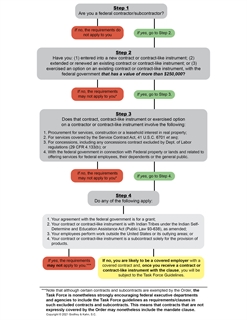
Wondering if you're subject to federal vaccine mandates? We've got you covered.
Biden’s Safer Federal Workforce Task Force publishes federal contractor and subcontractor guidance – Are you covered?
Wondering if you're subject to federal vaccine mandates? We've got you covered.
Biden’s Safer Federal Workforce Task Force publishes federal contractor and subcontractor guidance – Are you covered?
Authored By
Practices
On Sept. 14, 2021, we provided a summary of U.S. President Joseph Biden’s recently released COVID-19 “Path out of the Pandemic” action plan. President Biden’s plan included an Executive Order directing his Safer Federal Workforce Task Force to publish guidance that expands the reach of his July Executive Order (the Order) to now encompass mandatory vaccinations and COVID-19 protocols aimed at protecting not only federal government agency employees, but also certain federal contractors and subcontractors. On Sept. 24, 2021, the Task Force published its guidance which can be found here (the Guidance).
In this 2-part series, we will walk through the elements of coverage and analysis employers should conduct in order to determine whether they are subject to the directives. In our second post we will cover the implications for covered federal contractors and subcontractors, including elements of compliance, important nuances, and steps to take to prepare for the upcoming deadlines.
WHO’S COVERED?
Employer coverage
The Guidance makes it clear that federal agencies will be responsible for incorporating the yet-to-be released vaccine mandate clause in contract and contract-like instruments (defined broadly as an agreement between two or more parties which creates an obligation that is enforceable or otherwise recognizable at law and includes, without limitation, any procurement actions, a purchase order, service agreements, job order, notice of an award, basic ordering agreement, letter agreement, etc.).
Important note: As the Guidance is drafted, only those employers that enter into a contract or sub-contract with the new mandate clause will be required to comply with the requirements of the Order. Until that happens, the contractor/subcontractor is not yet covered.
In advance of the inclusion of the required clause in your contract, you can use the steps outlined below to determine whether your contract or sub-contract is likely to be a contract covered by the Order.
Step 1 – Are you a federal contractor/subcontractor?
- If no, the requirements do not apply to you.
- If yes, go to Step 2.
Step 2 – Have you: (1) entered into a new contract or contract-like instrument; (2) extended or renewed an existing contract or contract-like instrument; or (3) exercised an option on an existing contract or contract-like instrument, with the federal government that has a value of more than $250,000?
- If no, the requirements may not apply to you.*
- If yes, go to Step 3.
Step 3 – Does that contract, contract-like instrument or exercised option on a contractor or contract-like instrument involve the following:
- Procurement for services, construction or a leasehold interest in real property;
- For services covered by the Service Contract Act, 41 U.S.C. 6701 et seq;
- For concessions, including any concessions contract excluded by Dept. of Labor regulations (29 CFR 4.133(b); or
- With the federal government in connection with Federal property or lands and related to offering services for federal employees, their dependents or the general public.
- If no, the requirements may not apply to you.*
- If yes, go to Step 4.
Step 4 – Do any of the following apply:
- Your agreement with the federal government is for a grant;
- Your contract or contract-like instrument is with Indian Tribes under the Indian Self-Determine and Education Assistance Act (Public Law 93-638), as amended;
- Your employees perform work outside the United States or its outlying areas; or
- Your contract or contract-like instrument is a subcontract solely for the provision of products.
- If yes, the requirements may not apply to you.*
- If no, you are likely to be a covered employer with a covered contract and, once you receive a contract or contract-like instrument with the clause, you will be subject to the Task Force Guidelines.
*Note that although certain contracts and subcontracts are exempted by the Order, the Task Force is nonetheless strongly encouraging federal executive departments and agencies to include the Task Force guidelines as requirements/clauses in such excluded contracts and subcontracts. This means that contracts that are not expressly covered by the Order may nonetheless include the mandate clause.
When will agencies start to incorporate the mandated clause?
The Order directs the Federal Acquisition Regulatory Council (FARC) to develop and manage the process of incorporating the required vaccine mandate clause into federal contracts by Oct. 8, 2021. It further requires that the clauses be incorporated in compliance with the requirements of the Administrative Procedure Act (APA) and failure to meet the APA requirements could jeopardize the enforceability of the Order.
Importantly, the Guidance clarifies that federal agencies are expected to incorporate the clause developed by the FARC into contracts and solicitations for contracts as follows:
- Covered contracts awarded prior to Oct. 15 where the performance is ongoing – the clause must be incorporated at the point which an option is exercised or an extension of the contract is made. This means that contracts awarded prior to Oct. 15, 2021, where the performance is ongoing, are not covered unless an option is exercised or an extension is made.
- New contracts – the language must be incorporated into contracts awarded, modified, renewed or extended on or after Nov. 14. Between Oct. 15 and Nov. 14, agencies: (a) must include the clause in the solicitation for the contract; and (b) are encouraged to include the clause in contracts awarded during this time period but are not required to do so unless the solicitation for such contract was issued on or after Oct. 15.
The same vaccine mandate clause must also be included in all subcontracts to the prime contract and the mandate may be communicated orally or in writing. In order words, if your organization has a covered contract and you subcontract another employer to help perform work pursuant to the covered contract, your organization will likewise be responsible for including the vaccine mandate clause in your subcontract. The Guidance further confirms that once the clause is incorporated into a subcontract, subcontractors are required to comply with the Order and are expected to flow-down the clause to their lower-tiered subcontractors.
The takeaways:
- Do not assume that just because an organization is a federal contractor that it is subject to the mandate.
- Assuming the Order is interpreted as currently written, only those employers that enter into a contract or sub-contract with the applicable language will be required to comply with the requirements of the Order. Until that happens, the contractor/subcontractor is not yet covered.
- Subcontractors should confirm with their prime contractor that the contract and services will subject the subcontractor to the requirements of the mandate.
- Given the tight turnaround for compliance, employers that are likely to have covered contracts or contract-like instruments should begin to develop processes and strategies to ensure they can meet compliance when the clause is incorporated in their contract. Set aside time to carefully read and digest the Task Force requirements to understand the obligations of the organization.
Our upcoming blog post will explore the requirements, which employees are subject to complying with the requirements, and strategies to prepare for compliance.
For more information on this topic, read part two of this series entitled, So Biden’s vaccine mandate for federal contractors applies to your business: Now what?, or contact a member of our Labor, Employment & Immigration Law Practice Group.



